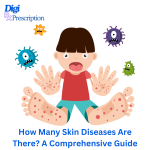
The skin is the largest organ of the human body and is susceptible to hundreds of diseases and disorders. From mild conditions like acne to severe autoimmune diseases like lupus, dermatologists have identified over 3,000 types of skin diseases. These conditions can be genetic, infectious, inflammatory, or environmental.
This article explores the most common types of skin diseases, their causes, symptoms, and treatments.
Types of Skin Diseases
1. Infectious Skin Diseases
These are caused by bacteria, viruses, fungi, or parasites and can spread from person to person.
Bacterial Infections:
Impetigo
Cellulitis
Boils
Leprosy
Viral Infections:
Chickenpox
Shingles
Measles
Warts (caused by HPV)
Fungal Infections:
Ringworm
Athlete’s foot
Candidiasis
Tinea versicolor
Parasitic Skin Diseases:
Scabies
Lice infestation
Leishmaniasis
???? Reference: World Health Organization (WHO)
2. Autoimmune and Inflammatory Skin Diseases
These occur when the immune system mistakenly attacks the skin, leading to chronic conditions.
Psoriasis – Causes red, scaly patches on the skin due to rapid skin cell production.
Eczema (Atopic Dermatitis) – Leads to dry, itchy, and inflamed skin.
Vitiligo – Results in loss of skin pigment, causing white patches.
Lupus – Affects multiple organs and can cause rashes and skin sensitivity.
Alopecia Areata – An autoimmune disease that causes hair loss.
???? Reference: American Academy of Dermatology (AAD)
3. Genetic and Hereditary Skin Conditions
Some skin diseases run in families and are inherited through genes.
Ichthyosis – Causes dry, scaly skin.
Epidermolysis Bullosa – A rare condition causing fragile skin that blisters easily.
Neurofibromatosis – Causes tumors to grow on nerves, leading to skin abnormalities.
???? Reference: National Organization for Rare Disorders (NORD)
4. Common Skin Disorders Due to Lifestyle & Environment
Factors like pollution, diet, stress, and climate can lead to various skin issues.
Acne – Affects millions worldwide, caused by clogged pores and bacteria.
Rosacea – Triggers facial redness, visible blood vessels, and acne-like breakouts.
Hives (Urticaria) – Caused by allergic reactions or stress.
Sunburn – Results from excessive sun exposure and increases the risk of skin cancer.
???? Reference: Mayo Clinic
5. Skin Cancers and Pre-Cancerous Conditions
Prolonged sun exposure, genetics, and environmental toxins contribute to skin cancer risks.
Basal Cell Carcinoma (BCC) – Most common and least aggressive skin cancer.
Squamous Cell Carcinoma (SCC) – Develops in sun-exposed areas.
Melanoma – The deadliest skin cancer, often appearing as an irregular mole.
???? Reference: Skin Cancer Foundation
How Many Skin Diseases Exist?
Dermatologists estimate that there are over 3,000 identified skin diseases, ranging from common issues to rare conditions. The field of dermatology continues to evolve with new discoveries and treatment options emerging each year.
???? Reference: British Journal of Dermatology
Conclusion
Skin diseases vary widely in severity, cause, and treatment options. While some conditions are temporary and treatable, others require lifelong management. Early diagnosis, proper skincare, and medical intervention can help prevent complications and improve quality of life.
Categories of Skin Diseases:
Infectious Skin Diseases:
Bacterial Infections: Impetigo, cellulitis, and leprosy.
Viral Infections: Warts (caused by human papillomavirus), herpes simplex, and molluscum contagiosum.
Fungal Infections: Athlete's foot, ringworm, and candidiasis.
Parasitic Infections: Scabies and lice infestations.
Inflammatory and Autoimmune Skin Diseases:
Psoriasis: Characterized by red, scaly patches.
Eczema (Atopic Dermatitis): Leads to itchy and inflamed skin.
Vitiligo: Causes loss of skin pigmentation.
Lupus: An autoimmune disease that can affect the skin, causing rashes and lesions.
Genetic Skin Disorders:
Ichthyosis: Results in dry, scaly skin.
Epidermolysis Bullosa: Causes fragile skin that blisters easily.
Albinism: Leads to a lack of melanin, resulting in very light skin, hair, and eyes.
Neoplastic Skin Diseases:
Benign Tumors: Moles, lipomas, and seborrheic keratoses.
Malignant Tumors: Basal cell carcinoma, squamous cell carcinoma, and melanoma.
Understanding the vast spectrum of skin diseases is crucial for accurate diagnosis and effective treatment. If you notice any persistent or concerning changes in your skin, it's essential to consult a healthcare professional or dermatologist for proper evaluation and care.
References:
American Academy of Dermatology: Skin Conditions by the Numbers
National Center for Complementary and Integrative Health: Skin Conditions at a Glance
National Institute of Arthritis and Musculoskeletal and Skin Diseases: Skin Diseases
World Health Organization: Recognizing Neglected Skin Diseases
